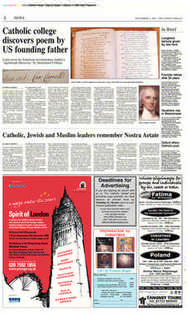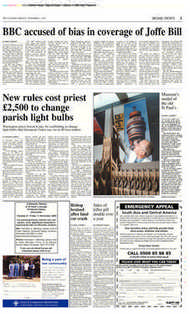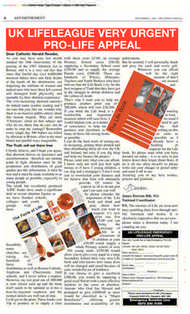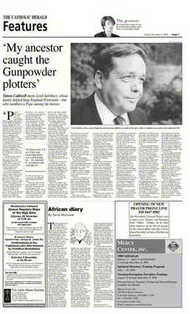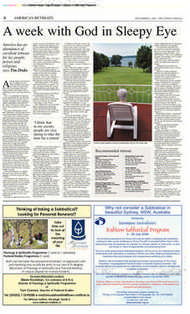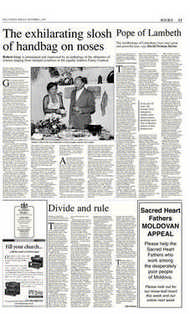Page 13, 4th November 2005
Page 13
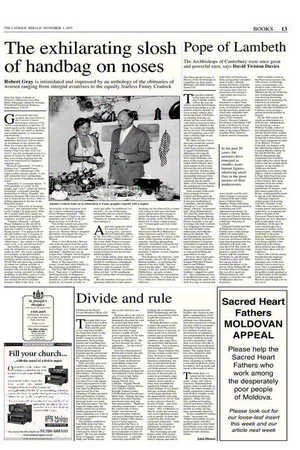
Report an error
Noticed an error on this page?If you've noticed an error in this article please click here to report it.
Tags
Share
Related articles
Princes Of The Church
Local Bulletin
Downside Benedictine Abbey Elects Distinguished Historian...
The Awesome Advantage Of Monastic Schools
Mitred Men And The Corridors Of Power
Pope of Lambeth
The Archbishops of Canterbury were once great and powerful men, says David Twiston Davies The Mitre and the Crown: A History of the Archbishops of Canterbury by Dom Aidan Bellenger and Stella Fletcher, Sutton £20 The greatest surprise in this book for ordinary Catholic readers will be the way the authors treat the Reformation. Instead of describing it as the greatest religious disaster to occur in these islands, they record the break with Rome so smoothly that one can almost feel the awed silence with which it must have been greeted by the faithful at the time. As a result this friendly survey of some 104 archbishops of Canterbury since 597 casts a striking light on our religious history.
The Mitre and the Crown does not contain the customary Anglican approach, which leaps on any evidence to suggest fundamental differences between the Celtic Church and Rome. Dom Aidan Bellenger, the prior of Downside, and coauthor Stella Fletcher show some interest in the rivalry between the sees of Canterbury and York. But they pay more attention to the strained relationship between Christ Church, Canterbury’s great cathedral, and the nearby abbey of St Augustine, where the archbishops were buried until the Reformation.
Their account of the oscillating struggle between Church and State picks up with St Anselm being forced to become Archbishop of Canterbury, and describing himself as “a weak old sheep” yoked to “an untamed bull”, King William Rufus. Yet when the clash between Archbishop Thomas Becket and King Henry II led to the former’s murder, it was the sovereign who had to submit to a whipping by the monks, who had not been overly enthusiastic about Becket during his lifetime. The development of canon law and the resulting increase of papal influence in England contributed to tensions, but these were eased when archbishops were royal kinsmen or were used to filling the great offices of state.
Even so, this did not guarantee their safety. The hottempered Richard II threatened to run William Courtenay through with his sword, while Simon of Sudbury’s support for a poll tax – that continuing red rag to the British electorate – led to him being torn apart by the mob. It is easy to assume that high office in Church and State extinguished considerations of man’s ultimate destiny, but Henry Chichele recorded on his tomb that he was a poor man who was raised up to be cast down “and turned into food for worms”.
The authors have given themselves a much wider brief here than in their earlier essay on England’s cardinals, but the necessary speed with which they undertake their task brings out the uncertainty of the Anglican Church. Thomas Cranmer, the primate when Henry VIII broke with Rome by Act of Parliament, ended up at the stake in the reign of Henry’s daughter Mary while his Catholic and his Protestant sister fought over his soul. After Cranmer’s successor Cardinal Pole died within hours of Queen Mary, Matthew Parker reluctantly took office. Although the first archbishop not to be appointed from Rome, he retained a scholarly interest in the early Church which so exasperated Puritans that they called him “the pope of Lambeth”.
Edmund Grindal and John Whitgift proved more to Puritan tastes while George Abbot was undeniably a Calvinist, though William Laud was associated with the high churchmanship that was abolished with their rank after the Civil War. Some 20 years later the hierarchy reappeared as a pillar of the Church with the restoration of Charles II, and all surely should have been well. Then the convert James II ascended the throne, to be driven off by William III, the Calvinist Prince of Orange; this was all to much for William Sancroft, who refused to swear the new oath of allegiance and was dismissed. With a further switch to the Hanoverian dynasty, the 18th-century archbishops were, unsurprisingly, too docile to cope with advancing Deism or the rise of Methodism. By the 1830s the now dominant Parliament was showing decreasing enthusiasm for protecting the Church as an essential support for the throne, particularly when the disabilities of Catholics were causing a serious political problem in Ireland.
By the 20th century the Anglican determination to demonstrate independence was becoming a strain. William Temple, author of the influential Christianity and the Social Order, emphasised its links with socialism, though the Labour Party was not overly impressed by need of an alliance. Winston Churchill was happier with the unhesitating support of Cardinal Hinsley during the Second World War, and Harold Macmillan later complained that Geoffrey Fisher talked too much about politics and not enough about religion. As the number of Anglicans declined, approaches were made to the papacy, which eventually led to Pope John Paul II praying with Archbishop Runcie at Christ Church. This made nonsense of all the earlier hostility, though many parishioners in the pew, with their deep-rooted fear of Rome, would probably prefer to link up with Methodism.
Although Anglicans earned praise for jousting with Mrs Thatcher in the 1980s, the concessions on women priests and homosexuality have so weakened the claim to be part of the Universal Church that the Nigerians are now clearing a path to take them out of Canterbury. In the past 20 years, the primates have emerged as smaller, more human figures, inhabiting small flats in the great palaces their predecessors enjoyed, struggling to hold everything together while leadership in the debate about abortion and euthanasia has been taken over by Catholics.
One is left with the uneasy thought that the Anglican Church’s only important monopoly now is the archbishops’ role in royal occasions. This is undoubtedly important in keeping at bay the godless hordes panting to get their hands on the historic fabric of our national life. But how much longer can we rely on it?
blog comments powered by Disqus



